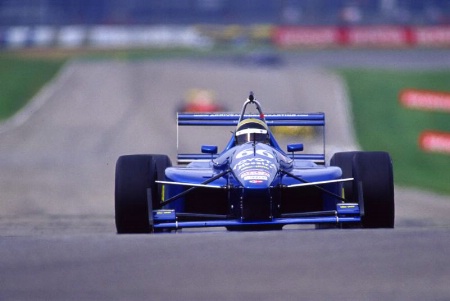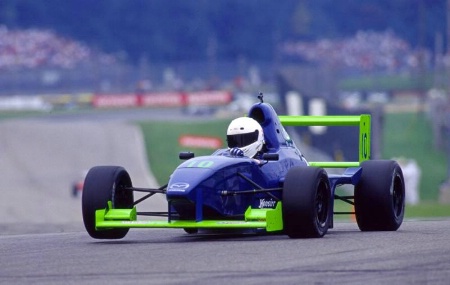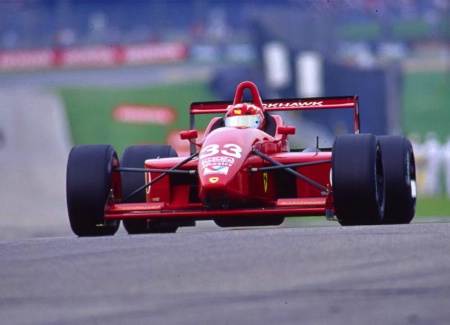
Mark Guiver |
|
Teleconverter or Extension tube for Motorsport
I have an E-500 DSLR with a 40-150 lens, and I want to get closer to my moving subject, motorbike racers, but cannot get beyond the safety fencing. What's my best and most cost-effective option? Teleconverter, extension tube, or even another lens?
Thanks!
August 29, 2008
|
|
|
W. |
|
Hi Mark,
Your 'best' option is another lens, image quality-wise. Your 'most cost effective option' is a teleconverter, but it ruins your image quality BIG time. You'd wish you hadn't wasted your money on it, because you'll never use it again after the first, very dissappointing time. An extension tube is for macro photography. It does NOT get you "closer to my moving subject, motorbike racers". So you had best save up until you can afford a real telephoto lens. You will regret it if you don't.
Have fun!Addendum: Using a telephoto focal length of over 150mm dictates the use of a decent tripod, because the built-in image stabilization can't hack it by a long shot (pun intended). You'll get bad camera shake if you try to shoot handheld.
August 29, 2008
|
|
|
Mark Guiver |
|
Many thanks for the swift responses here. The TC seems to cost as much as a new lens anyway. Extension tubes are very cheap, but then thats because they are just empty plastic tubes! OK, so a new lens is the preferred option. But, that then leads to the question of which one? Olympus or Sigma? 18-180 (I could sell the 40-150), 50-200 (seems expensive) or 70-300?!
August 29, 2008
|
|
|
Oliver Anderson |
|
Mark, to capture motorsports you need a fast lens - hopefully with (IS) image stabilization of some sort. The faster lens has a lower f/stop like 2.8 and is accompanied with a higher price. When you add a teleconverter, you lose a stop or 2 ... 1.4x or 2x, which makes the lens even slower but closer to the action. I shoot AMA and NASCAR with a f/2.8 w/1.4x teleconverter, so the lens becomes an f/4 lens ...
Simply put, buy the lens that has the lowest f/stop you can afford and has a good review.
August 29, 2008
|
|
|
Alan N. Marcus |
|
Hi Mark, Your Olympus E-500 sports a Kodak digital sensor that measures 13mm by 17.3mm. Using math we can calculate the diagonal measure of this 4:3 aspect ratio rectangle as 21.64mm. Known the size of the sensor and its diagonal measure is an important piece of information when it comes to lens selection. A “normal” lens for this camera (one that replicates the human experience is a lens with a focal length about equal to the diagonal measure. That means “normal” for this camera is 20mm. Note this camera is usually sold with a zoom lens that covers the range 14mm ~ 45mm. Note 20mm falls in the center of this zoom range. That being true, setting the zoom to 40mm causes images to appear twice as close i.e. the view is said to be 2x greater or about the equivalent of halving the camera to subject distance. Thus mounting a 80mm will half again giving a magnification that is said to be 4x normal. If you mount a 160mm, that view would be 8x normal. At 8x normal a subject 100 yards away would appear (compared to “normal”) 12.5 yards or 25 feet away. You can’t mount an extension tube and cause the camera lens to function like a telephoto. Extension tubes work at very close camera-to-subject distances. This is due to the fact that when work at extreme close-up distances the lens focal length as engraved on the barrel of our lens becomes invalid, it lengthens. Actually it becomes 2x longer as we approach life-size (unity or 1:1). To achieve focus the lens must be extended outward towards the subject. Since most camera focus mechanisms limit forward travel we must resort to extension tubs as these circumvent the mechanical limit of forward travel allowing the lens to be re-positioned frontward. As to magnification: Most books list 50mm as “normal” and state that a 100mm gives 2x magnification and 100mm yields 4x etc. This is true for the full frame 35mm that sports a diagonal measure that rounds up to 50mm. Your camera sports a 20mm diagonal thus 40mm = 2x – 80mm = 4x – 160mm = 8x – 320mm = 16x. Nobody said it’s easy. Alan Marcus (marginal technical gobbledygook)
alanmaxinemarcus@att.net
August 29, 2008
|
|
|
Oliver Anderson |
|
I was going to say that before Alan took the words and put them to paper first....this is how far I got.
Your Olympus is a camera. Uhhhhhhh Alan take it from here.
August 29, 2008
|
|
|
Samuel Smith |
|
welcome mark,
sigma has a 135-400 f4.5-5.6 for around 800 bucks for the 4/3rds system. I can't imagine what an f2.8 lens,if available,would cost for your camera.
I shoot r/c fly-ins at 300mm handheld with great results.yes,results may vary.
good luck,sam
August 29, 2008
|
|
|
James Kirk |
|
|
|
|
|

Formula Atlantic 66
Captured during the SCCA Championships at the Mid-Ohio Sports Car Course. This is a Formula Atlantic car, the precursor ride to Indy Car. Shot with the spectacular Canon 400mm f2.8 lens with 1.4x extender.
James Kirk
|
|

|

Formula Atlantic 10
Captured during the SCCA Championships at the Mid-Ohio Sports Car Course. This is a Formula Atlantic car, the precursor ride to Indy Car. Shot with the spectacular Canon 400mm f2.8 lens.
James Kirk
|
|
|
|

Formula Atlantic 33
Captured during the SCCA Championships at the Mid-Ohio Sports Car Course. This is a Formula Atlantic car, the precursor ride to Indy Car. Shot with the spectacular Canon 400mm f2.8 lens.
James Kirk
|
|
|
|
Some lenses have the ability to turn off the horizontal image stabalization. This is a great boon for motor sports since one is often panning with the bike/car. You get vertical stability with out confusing the lens. The other thing is, get a monopod. Don't use a tripod, it is severly limiting when shooting objects moving that fast. Contrary to what W.S. says, I have had very good successes with 1.4x extender. On my Canon EOS 1 (film) with the 1.4x II and a 400 2.8 I got great images at the SCCA championship events a few years ago. Let's see, 1 Canon 400mm f2.8 L $6,800.00 , Canon 1.4x extender $290.00. Hmmm, maybe not so cost effective. I rented. Best thing I ever could have done. Seriously though, long fast lens and a monopod will get you into the action. Seek out spots on the track where you can get closer with good view of vehicles under breaking, entering and the apex of corners. Most action their. But better yet, strike up a relationship with one of the teams, get registered with the team and you can often get a pass to get out where the pros are. That's what we did. Access is everything for motorsports. Good luck.
September 02, 2008
|
|
|
Samuel Smith |
|
i saw no mention of pompous james.c'mon w.s.,you can't is meant to be changed.
well he is using film which is cheating?
thanks for sharing the photos and touching base,sam
September 02, 2008
|
|
|
BetterPhoto Member |
|
Lord W, you getton UUUUGGGGLLLLYYYY!!!!!
September 05, 2008
|
|
|
eric brown |
|
mark I got a cheaper way for you to try. try talking to the promoter about getting inside the fence they arent going to let you to the start line at indy or daytona but if its a local track you might just be able too I just did a track shoot from the inside an it was great shots an angles no one else gets an all I had to do was file share with the promoter an you dont have to buy any thing well its just a thought eric
September 06, 2008
|
|
|
Harold W. Motte |
|
Hi, don't know if youv'e had this answer but that lens will not take a teleconverter anyway. TC's and zooms usually don't make for the best solution.
TC's and primes do. A long prime for your e-500 is expensive. Even the Oly Tc's are expensive by themselves and you have to have one of their exp. primes. A tc on a zoom is no recommended. So, maybe the 200mm lens, they have come down a little used. Then you could add a oly tc to that.
Check the OLy website and it will give you this inof that that lens will no take a TC. Good luck.
September 07, 2008
|
|
|
John G. Clifford Jr |
|
Unless you're shooting macros, an extension tube is not what you're looking for. Teleconverters can be very useful, as long as you understand that you'll lose one (1.4x) or 2 (2x) stops when you hook them onto the back of your lens. Also, some teleconverters are better optically than others, even from the same manufacturers. For instance, the Sigma TC14 1.4x teleconverter has little to no effect on the image quality of a good telephoto lens and works especially well with the 70-200/2.8 EX or 100-300/4 EX lenses. Modern dSLRs that are well-suited for action photography let you shoot at higher ISOs and still get excellent quality. Shooting on a sunny day at ISO 400 and f/5.6 or f/8 will put your shutter speed at 1/1000 or faster, and that should be fast enough. Additionally, as someone else pointed out, apparent magnification is all. Your 4/3rds sensor-equipped Oly dSLR will give the same field of view with a 200mm lens as James' 400mm lens, and at the same max aperture, for thousands less. Putting a 1.4x TC on that lens gives you the same field of view and max aperture as a 560/4 lens on a 35mm SLR or full-frame dSLR. That should be plenty enough for auto racing. And finally... if you want good images, get a GOOD lens. The 55-200 and 70-300 lenses you list above are, well, okay. They're not great. Great is going to run you towards the $1000 mark, but then you'll have a lens that will produce world-class images... if you can.
September 10, 2008
|
|
|
W. |
|
"12.5 yards or 25 feet away"Huh? 12.5 yards = 450 inches = 1,143 centimeters
25 feet = 300 inches = 762 centimeters So, pray, how is 12.5 yards anywhere near equal to 25 feet, Alan?
September 11, 2008
|
|
|
Alan N. Marcus |
|
Hi W. S. When a 20mm focal length is “normal”: 40mm focal length magnifies 2x thus an object 100 yards (300 ft.) appears as if it were only 50 yards (150 ft.) distant. 80mm cuts the apparent distance in half again, the magnification is 4x, now the object has an apparent distant of 25 yards (75 ft.). 160mm cuts the apparent distance in half again, the magnification is 8x, now the object has an apparent distant of 12 ½ yards (37 ½ ft.). Now look what you did, my crown sits a little lopsided! Alan Marcus (dispenses marginal technical gobbledygook)
September 11, 2008
|
|
|
|
Log in to respond or ask your own question.
|